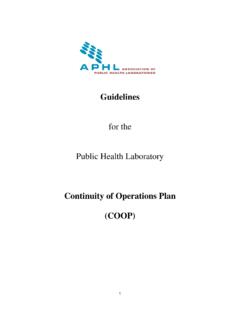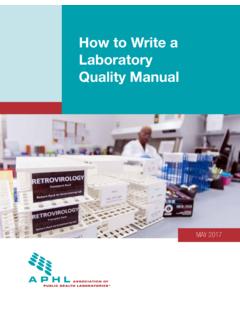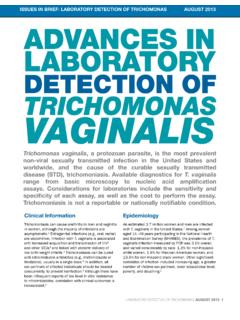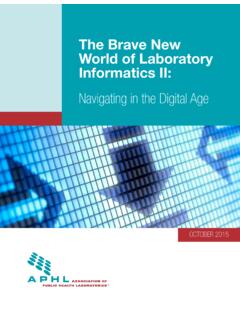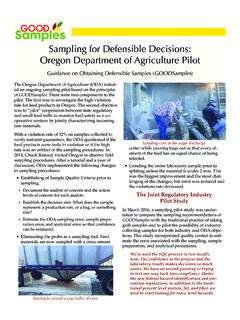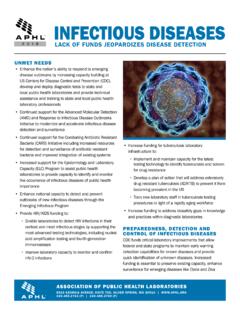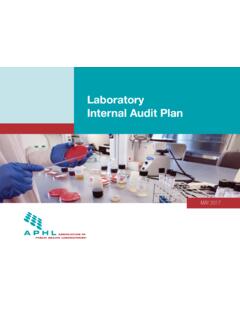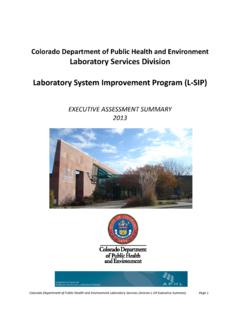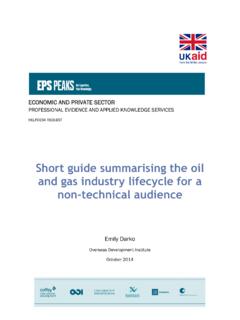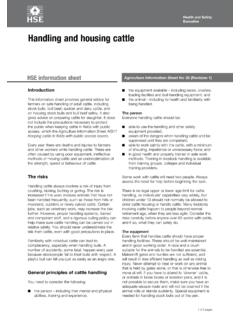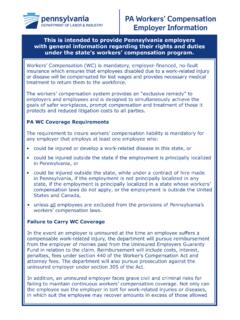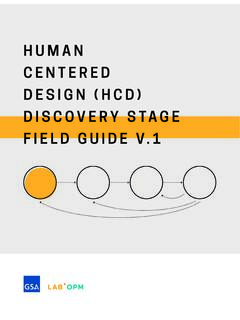Transcription of SARS-CoV-2 Wastewater Surveillance Testing Guide for ...
1 SARS-CoV-2 Wastewater Surveillance Testing Guide for Public Health Laboratories MARCH 2022.. CONTENTS. Overview of Wastewater -based Disease Role of Public Health Laboratories in Wastewater Surveillance Wastewater Surveillance Testing Wastewater 5. Wastewater Testing 6. Variant Tracking Through 7. Testing Scale and Reporting 7. Laboratory Infrastructure for Wastewater Laboratory 8. Laboratory Space and Equipment 8. General Required 8. Method Specific Equipment .. 9. Spatial Layout for Contamination 9. 10. Risk 10. Waste 11. Information Technology, Security, and Data 11. Example: Robust Data Management 12. Program Performance Training and Proficiency 12. Internal Quality Assessment and Method 12. 1. Precision .. 13. 2. Accuracy .. 13. 3. Contamination .. 15. 4. 15. 5. Endogenous Wastewater Controls .. 16. 6. Limits of Detection (LOD).. 16. 7. Limit of Quantification (LOQ).. 16. External Quality Assessment and Accreditation.
2 16. Laboratory Data Reporting 17. Reporting 17. Reporting 17. Reporting 17. Reporting Method 17. Appendix A: List of Appendix B: Glossary of Appendix C: Programmatic Decisions Involving Testing Appendix D: Additional All the information contained in this document is based upon current information. APHL will plan to update this document as needed. APHL SARS-CoV-2 Wastewater Testing Guide | 2. OVERVIEW OF Wastewater -BASED DISEASE Surveillance . The purpose of this document is to provide an overview of the SARS-CoV-2 Wastewater laboratory setup and analytical process to orient public health laboratories as they implement Testing . This guidance provides details on the management system and controls needed to produce quality, robust Wastewater Testing data that can be reported to health officials and to the US Centers for Disease Control and Prevention (CDC) National Wastewater Surveillance System (NWSS) for public health decision making.
3 Topics covered include the role of the public health laboratory in Wastewater Surveillance , Wastewater Surveillance Testing methods, laboratory infrastructure needed for Wastewater Testing and program performance evaluation. Wastewater Surveillance is the strategic sampling and Testing of Wastewater to detect pathogens or other health targets to better understand disease burden and spread within a community. Wastewater Surveillance is a promising tool for the COVID-19 response because the virus is shed in the feces of up to 80% of infected individuals both symptomatic and asymptomatic. Wastewater data are also unique from case-based Surveillance because Wastewater Surveillance captures subclinical infections and data are independent of healthcare-seeking behavior and Testing access. Since a large portion (~75%) of feces in the United States will be flushed into sewers and arrive at a Wastewater treatment facility within hours, untreated Wastewater can be seen as an efficient pooled fecal sample representing community level or sub-community level infections if strategically sampled from within the piped network.
4 Finally, Wastewater data have shown to be a leading indicator of trends in new reported cases by anywhere from four days to even a few weeks. With these benefits, it is important to note Wastewater cannot determine the most effective mitigation strategies for reducing transmission within a community. Consequently, Wastewater -based disease Surveillance is not a solution to be used in isolation, but instead a tool used to complement other public health measures and indicators. For more information on Wastewater Surveillance , see the NWSS website, which includes an overview of Wastewater Surveillance , the advantages of this approach and guidance on engaging with NWSS. The site also provides guidance for implementing Wastewater Surveillance , including developing sampling strategies, Testing methods, data reporting and analytics, public health interpretation and use, targeted Wastewater Surveillance at facilities, institutions and workplaces, and application in low-resource waste systems.
5 More resources can also be found in Appendix D. ROLE OF PUBLIC HEALTH LABORATORIES IN Wastewater Surveillance . Testing . Wastewater Surveillance for the COVID-19 response started as a grassroots effort by researchers and Wastewater utilities BENEFITS FOR ESTABLISHING. to demonstrate the power of this emerging public health tool. As this effort grows into a sustainable, nationwide disease Wastewater Testing IN THE. Surveillance system, Wastewater Testing will need to rapidly PUBLIC HEALTH LABORATORY. transition out of the research laboratory and into industry Ability to rapidly adjust Testing scale and and public health laboratories that can provide the necessary Surveillance targets based on public health need capacity and public health reporting abilities. Public health laboratories are particularly well-suited for this type of Testing Facilitate reporting of Testing data to because, unlike traditional environmental Testing for regulatory- epidemiologist and public health decision makers based prevention monitoring, the Wastewater data are used for Robust interpretation of data resulting from this public health action.
6 As such, these Wastewater data are more unique sample type that may be unfamiliar to similar to clinical test results for public health Surveillance and many epidemiologists and medical doctors response, which require rapid coordination with public health Potential for future harmonization of partners. Public health laboratories will also play an important methodologies/data interpretation role in expanding Wastewater Surveillance targets beyond COVID-19, informing future target development with community Network of connected labs where new needs needs. could be rapidly implemented across the nation APHL SARS-CoV-2 Wastewater Testing Guide | 3. Wastewater Surveillance provides a flexible platform to tailor targets as needed, from antibiotic resistance to emerging pathogens. Figure 1 describes the data flow for NWSS and highlights the role of laboratories in coordinating between key stakeholders at Wastewater utilities and public health departments.
7 See NWSS for more information on Wastewater data reporting and use of Wastewater Surveillance data. Figure 1. Schematic of the data flow for the United States CDC National Wastewater Surveillance System (NWSS). Public health laboratories conducting Wastewater Testing serve as an efficient link between utilities collecting and submitting samples and public health epidemiologists and decision makers analyzing and reviewing the data. Source: Wastewater - Wastewater Surveillance Testing METHODS. There is no single method for SARS-CoV-2 Testing for Wastewater Surveillance . The amount and type of processing required to concentrate a Wastewater sample for viral quantification will be dependent on a variety of factors, including the number of infections in the community and the sampling location. For example, sludge samples, also called biosolids, can only be collected at certain Wastewater treatment plants.
8 In addition, COVID-19 infection rates have been sufficiently high in certain locations where concentration of a Wastewater sample was not needed for quantification of the virus. Instead of a single standard method, there are standard performance criteria and quality controls required for Wastewater Testing mandated by public health reporting systems, such as NWSS. A public health laboratory will choose a Wastewater Testing method from a suite of high performing options based on laboratory capacity and both local and national public health data needs. Figure 2 presents an overview of the Wastewater Testing process. Following sample collection, the first step in SARS- CoV-2 Wastewater Testing is sample preparation, consisting primarily of homogenization of the sample through processes like blending or sonication. During this step, a matrix recovery control should be spiked into the sample. The second step is sample concentration of the virus, through procedures such as filtration or pelleting by centrifugation.
9 The third step is RNA extraction from the concentrated Wastewater sample using methods that are specifically designed to remove high concentration of environmental inhibitors. The final step is RNA measurement by reverse transcription quantitative APHL SARS-CoV-2 Wastewater Testing Guide | 4. polymerase chain reaction (RT-qPCR), RT digital PCR (RT-dPCR), or droplet digital PCR (ddPCR). These steps in the Testing methodology are further Sample Spike Matrix Prepara on Recovery Control described on the NWSS Testing Methods website and in the resources provided for this section. Example Wastewater Testing protocols that have demonstrated robust method performance are provided by NWSS on Sample Concentra on BSL2+. Wastewater Samples Sample type is an important consideration for collecting representative RNA Extrac on samples and will depend on the sample collection location and factors specific to the Wastewater treatment system.
10 There are two Wastewater Include RNA. Surveillance sample types: untreated Wastewater and primary sludge. Measurement Quan ta ve Recovery Control Untreated Wastewater includes waste from household or building use ( , toilets, showers or sinks), which contains human fecal waste, as Assess Inhibi on Measure Controls: Measure well as waste from non-household sources ( , rainwater or industrial Human fecal control Matrix recovery control SARS-CoV-2 . use). Untreated Wastewater may be sampled from Wastewater treatment Quan ta ve control plant influent prior to primary treatment, or upstream in the Wastewater collection network. Primary sludge comprises suspended solids that settle Figure 2. Overview of Wastewater Testing out of Wastewater during the first solids removal ( sedimentation ) process process. While untreated Wastewater is at a Wastewater treatment plant. Primary sludge is distinct from secondary visually represented, the major steps are consistent for sludge and swab sample types.
